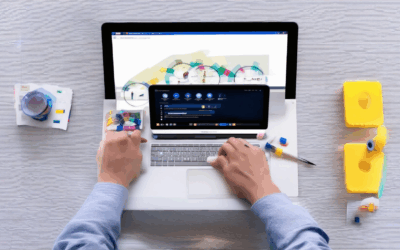Have you ever wondered how some websites consistently outperform others in terms of design, functionality, and user engagement? The answer often lies in the power of web design case study examples. These detailed examinations of real-world projects provide invaluable insights into the strategies, decisions, and tools that drive success. By analyzing these case studies, designers can uncover proven approaches, learn from both achievements and mistakes, and gain inspiration for their own projects. Whether you’re working on a new website or refining an existing one, understanding the principles behind successful designs is crucial. In this article, we’ll explore how web design case study examples can illuminate the path to creating exceptional digital experiences, across various industries and objectives.
Key Takeaways
- Aligning Design with Brand Identity: Successful web design case studies show how color schemes, typography, and layouts consistently reflect a brand’s identity, enhancing recognition and user trust.
- Enhancing User Experience: These studies reveal the impact of intuitive navigation, responsive design, and seamless interactions, significantly reducing bounce rates and improving user satisfaction.
- Optimizing Content Strategy: Effective case studies demonstrate how content is structured to meet user needs, incorporating SEO optimization and engaging formats that drive engagement.
- Technical Excellence: Insights often highlight the use of efficient CMS platforms, coding practices, and performance tweaks like lazy loading, ensuring fast and reliable websites.
- Seamless SEO & Analytics Integration: Case studies illustrate how SEO strategies and analytics tools boost performance, improving organic traffic and conversion rates.
- Fostering Collaboration: Successful projects result from teamwork between designers and developers, balancing aesthetics with functionality to deliver exceptional user experiences.
- Adapting to Trends: Examples show how designs evolve to embrace new trends, ensuring websites remain relevant and competitive in a dynamic digital landscape.
- Elevating Designer Skills: Case studies provide real-world lessons, inspire creativity, and build portfolios, helping designers refine their technical and problem-solving abilities.

What Makes a Great Web Design Case Study?
A great web design case study is a detailed narrative that effectively communicates the process, challenges, and outcomes of a successful web design project. Here’s what sets an exceptional case study apart:
1. Clear Objectives and User-Centered Focus
A standout case study begins with a well-defined problem statement and clear goals. It demonstrates how the design addressed specific user needs through research and testing, ensuring the solution was tailored to the audience.
2. Visual Evidence and Measurable Outcomes
Incorporate before-and-after visuals, such as screenshots or mockups, to showcase transformations. Include specific metrics, like increased conversion rates or improved user engagement, to quantify success.
3. Key Takeaways and Lessons Learned
Extract actionable insights from the case study. Highlight design decisions that worked and those that didn’t, offering practical advice for future projects.
4. Competition and Market Positioning
Mention competitors neutrally to position your brand. Show how your design stands out in the market, emphasizing unique features and benefits.
5. Resources and Further Reading
Include links to additional resources, such as tools or articles, to help readers explore topics mentioned. Use links like this one naturally within the content.
6. SEO Optimization
Ensure the case study is SEO-friendly with relevant keywords and proper tags. This enhances visibility and accessibility for future readers.
By following these guidelines, you create a case study that is not only informative but also engaging and easy to digest.
Key Components Typically Included in Web Design Case Studies
A well-crafted web design case study serves as a valuable resource for designers, developers, and stakeholders. Here are the essential components commonly included:
1. Project Objective
- Clearly defines the purpose of the project, such as improving user experience, increasing conversions, or achieving specific business goals.
- Explains the target audience and the primary challenges to be addressed.
2. Research & Discovery Process
- Details the methods used to understand the client’s needs, market trends, and competitive landscape.
- Includes user surveys, competitor analysis, and stakeholder interviews.
- Describes the discovery phase, where ideas are generated and refined.
3. Design Approach
- Outlines the design principles and methodologies employed, such as user-centered design or agile development.
- Explains the tools and frameworks used, such as wireframing, prototyping, or responsive design.
- Describes the collaboration between the design and development teams.
4. Implementation & Execution
- Provides a step-by-step account of how the design was translated into a functional website or application.
- Shares the technical details, such as coding, testing, and deployment processes.
- Discusses the challenges faced during execution and how they were overcome.
5. Results & Outcomes
- Highlights the measurable successes, such as increased traffic, improved conversion rates, or enhanced user engagement.
- Includes before-and-after comparisons to demonstrate the impact of the design changes.
- Tracks long-term metrics, such as user retention or revenue growth.
6. Takeaways & Lessons Learned
- Summarizes key insights and best practices gained from the project.
- Identifies areas for improvement and potential pitfalls to avoid in future projects.
- Offers recommendations for stakeholders, designers, and developers.
Conclusion
- Reinforces the importance of the case study as a reference for future projects.
- Encourages sharing the findings within the design community to foster learning and collaboration.
By examining these components, designers can gain valuable insights and apply similar approaches to their own projects. For more detailed examples and resources, visit 119WebDesign.com .

What Can Web Design Case Study Examples Reveal About Effective Website Creation?
Web design case study examples offer valuable insights into effective website creation by showcasing real-world applications of design principles, user experiences, and technical implementations. Here’s what they can reveal:
- Alignment with Brand Identity : Successful case studies demonstrate how design elements like color schemes, typography, and layout align with a brand’s identity, ensuring consistency and reinforcing brand recognition.
- User Experience (UX) Optimization : They highlight the impact of intuitive navigation, responsive design, and seamless user interactions on improving usability and reducing bounce rates.
- Content Strategy Effectiveness : These studies often reveal how content is organized and presented to meet user needs, incorporating techniques like information architecture, SEO optimization, and engaging content formats.
- Technical Implementation Details : Insights into the use of reliable CMS platforms, efficient coding practices, and performance optimizations, such as image lazy loading or lightweight frameworks, are common.
- SEO and Analytics Integration : Case studies show how websites have improved performance through SEO strategies, keyword targeting, and conversion tracking using tools like Google Analytics.
- Collaboration Between Designers and Developers : They emphasize the importance of teamwork, where feedback from both parties leads to iterative improvements, balancing aesthetics with functionality.
- Adaptability to Trends : Examples often depict how designs evolve to stay relevant, adopting new trends in color palettes, typography, and interactive elements.
By examining these aspects, web design case study examples provide actionable lessons for creating websites that are not only visually appealing but also functional, user-friendly, and aligned with business goals.

What Can Web Design Case Study Examples Reveal About Effective Website Creation?
Web design case study examples offer valuable insights into effective website creation by showcasing real-world applications of design principles, user experiences, and technical implementations. Here’s what they can reveal:
- Alignment with Brand Identity : Successful case studies demonstrate how design elements like color schemes, typography, and layout align with a brand’s identity, ensuring consistency and reinforcing brand recognition.
- User Experience (UX) Optimization : They highlight the impact of intuitive navigation, responsive design, and seamless user interactions on improving usability and reducing bounce rates.
- Content Strategy Effectiveness : These studies often reveal how content is organized and presented to meet user needs, incorporating techniques like information architecture, SEO optimization, and engaging content formats.
- Technical Implementation Details : Insights into the use of reliable CMS platforms, efficient coding practices, and performance optimizations, such as image lazy loading or lightweight frameworks, are common.
- SEO and Analytics Integration : Case studies show how websites have improved performance through SEO strategies, keyword targeting, and conversion tracking using tools like Google Analytics.
- Collaboration Between Designers and Developers : They emphasize the importance of teamwork, where feedback from both parties leads to iterative improvements, balancing aesthetics with functionality.
- Adaptability to Trends : Examples often depict how designs evolve to stay relevant, adopting new trends in color palettes, typography, and interactive elements.
By examining these aspects, web design case study examples provide actionable lessons for creating websites that are not only visually appealing but also functional, user-friendly, and aligned with business goals.
How Do Web Design Case Study Examples Help Designers Improve Their Skills?
Web design case study examples are a powerful tool for helping designers refine their skills and stay ahead in their field. Here’s how they contribute to skill improvement:
- Real-World Application:** Case studies provide tangible examples of how problems were identified, solved, and executed. By analyzing these examples, designers can learn practical lessons that translate directly to their own projects.
- Inspiration and Trends:** Great case studies showcase cutting-edge designs, emerging trends, and innovative solutions. They inspire designers to push creative boundaries and experiment with new techniques.
- Practical Learning:** Case studies often document the decision-making process, including challenges faced and how they were overcome. This insight allows designers to develop problem-solving skills and understand the nuances of effective design.
- Portfolio Building:** Including case studies in a portfolio demonstrates a designer’s ability to execute successful projects. They serve as evidence of technical proficiency, creativity, and project management skills.
For instance, exploring case studies on platforms like 119WebDesign or Awwwards can offer valuable insights and inspiration. These resources allow designers to dissect successful projects, identify patterns, and apply similar strategies to their own work.

Insights from Web Design Case Studies
Web design case studies offer valuable insights into successful website design by showcasing real-world applications of design principles, user experiences, and technical implementations. Here are some key takeaways:
- User-Centered Design Approach:** Case studies often highlight the importance of prioritizing user needs and preferences. By conducting thorough user research, such as surveys, interviews, and analytics, designers can identify pain points and tailor solutions to meet specific user behaviors. For example, a travel website case study might reveal how they simplified the booking process based on user feedback, reducing bounce rates by 20%.
- Responsive Design Implementation:** With the rise of mobile devices, responsive design has become a cornerstone of successful web design. A retail e-commerce case study might demonstrate how a company achieved a 30% increase in mobile sales by ensuring their site was fully responsive and provided a seamless shopping experience across devices.
- Content Strategy Optimization:** Effective content organization and presentation are critical for user engagement. A news portal case study might illustrate how they increased average time spent on the site by restructuring content into digestible sections and optimizing image loading speeds.
- Visual Hierarchy and Typography:** Clear visual cues and effective typography guide users through the site. A financial services case study might show how they used a bold color scheme and large, readable fonts to enhance trust and ease of navigation.
- Accessibility Features Integration:** Inclusive design practices, such as adding alt texts for images and ensuring keyboard navigation works, are vital for broad reach. A government website case study might detail how they implemented these features to cater to users with disabilities, achieving a 15% increase in accessibility compliance ratings.
- SEO Best Practices:** While often seen as a developer’s task, SEO impacts design. A blog platform case study might explain how they optimized image file names and structured content with proper meta tags, leading to a 25% improvement in organic traffic.
- Brand Identity Consistency:** Maintaining brand consistency across all touchpoints is crucial. A lifestyle brand case study might demonstrate how they unified their logo, color palette, and typography across desktop and mobile versions of their site, reinforcing brand recognition.
- Performance Optimization:** Fast-loading sites are more likely to retain users. A SaaS application case study might showcase how they reduced page load times by 40% through minification and lazy loading techniques, resulting in a 10% boost in conversion rates.
- Cross-Functional Collaboration:** Success often stems from teamwork between designers, developers, and marketers. A hospitality website case study might highlight how their cross-functional team collaborated to integrate a booking engine seamlessly, improving direct bookings by 35%.
- Data-Driven Design Decisions:** Analytics tools provide valuable insights into user behavior. A streaming service case study might reveal how they used heatmaps and user retention reports to redesign their interface, increasing session duration by 25%.
- Iterative Design Process:** Continuous testing and refinement lead to better outcomes. A healthcare website case study might describe how they iteratively improved their appointment booking form based on A/B testing results, cutting completion time by 15%.
Conclusion: Web design case studies are powerful tools for learning. They provide tangible examples of how design choices impact user experience, business goals, and technical performance. By analyzing these case studies, designers can gain actionable insights, refine their approaches, and create more effective websites tailored to their audiences.




0 Comments